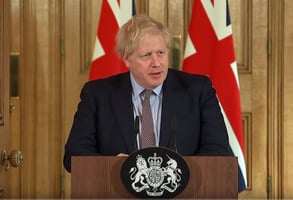We’re all using it.
Forgive me.
I hadn’t intended to write about Boris Johnson again so soon in one of our blogs.
We know we only recently covered the complications caused by his “not a corrupt country” remarks during COP26.
But we can’t ignore his speech to the Confederation of British Industry yesterday.
The Prime Minister’s performance has been described as “shambolic”,
“embarrassing” and “a mess”. And that is the reaction from the people in his party.
When Sky News cut away from the speech, presenter Ian King described it as “excruciating”.
It was hoped the speech would see Mr Johnson announce proper policy in pursuit of the levelling up agenda.
Instead, he recounted a visit to Peppa Pig World, criticised the civil service for not creating the cartoon character, imitated a car and compared himself to Moses.
And then there was the uncomfortable part where he completely lost his place, leaving him to mutter “blast” and “forgive me” repeatedly as he attempted to get his speech notes back into some semblance of order.
Mr Johnson is known for his blustering style. But this was different.
Such was the chaotic and rambling nature of his performance that one journalist asked him afterwards if he was ok.
So, what can we learn from this? Here are a few lessons from our presentations skills training courses.
Notes
Let’s start with the notes debacle. Footage of the Prime Minister desperately trying to get his speech notes back in order has been shared extensively online.
Speech notes should not be a script.
They should be there to guide and prompt you through your presentation, focusing on the main themes and messages you want to get across.
It could be as simple as having a few bullet points or headlines on cards that remind you of what should come next.
Although it didn’t happen here, extensive notes can remove spontaneity from the presentation and cause presenters to deliver robotic, lifeless performances – creating a dull experience for audiences.
If you do print your presentation on A4 – and this is not a recommendation – at least put some page numbers at the bottom so you can easily find your place.
Preparation
Preparation is at the heart of every good speech or presentation.
Every memorable speech that has compelled, educated and entertained audiences has done so because of good preparation.
We often use a quote from Mark Twain to illustrate this during business presentation coaching.
He famously said: “It usually takes me more than three weeks to prepare a good impromptu speech.”
Bullet points, mind maps and message preparation sheets will all help you to plan your presentations effectively.
Always think about your audience and your message. Can you come up with a one-sentence description that describes who you are talking to?
For example: Senior managers of a large university hospital, aged 40-55, mostly male and all with business degrees or MBAs.
Once you are clear on who you are talking to, you can focus on what you want to tell them.
What is the main point you want them to take away? How can you make what you say relevant, captivating and memorable?
Examples and personal stories
And this brings us neatly to the Prime Minister’s visit to Peppa Pig World – something that has hogged much of the coverage of the speech.
On our public speaking courses, we stress the importance of presenters sharing examples and personal stories and anecdotes.
Human and personal examples are crucial for bringing presentations to life, capturing the audience’s attention and making messages memorable.
But – and here is the crucial bit – they need to be relevant to what you want to get across and the people you are talking to.
Peppa Pig World, as good as it might be, is around 300 miles away from the Port of Tyne, where this speech took place.
How many people in the audience would have visited the attraction?
Michael Stirrup, chief executive of Waterstons, was in the audience and said afterwards: “It was interesting that he asked a group of business leaders in the north-east if they had travelled six hours down the road to Peppa Pig World and then talked about levelling up.
“It shows a bit of a lack of understanding, I think.”
Stuck
Losing your train of thought or suffering a memory lapse is something many speakers worry about.
It can feel mortifying. And most of us don’t have the added pressure of clips of our speech or presentation appearing on TV news or trending on social media.
So, what should you do if your mind goes blank?
Firstly, don’t stop talking. The longer you remain silent and mutter things under your breath, the more awkward and uncomfortable it is going to become. Reiterate your previous point. Ask the audience a question. Take a sip of water. These approaches can buy you a little thinking time to get back on track and regain your composure.
And they can help you avoid panic which will only make matters worse.
Sometimes, people lose their train of thought because they put pressure on themselves to deliver a perfect performance.
But no one expects presenters to be perfect. The audience wants to gain your insight. They are on your side and will forgive a few mistakes.
Structure
When presentations go badly wrong, the cause of the issues can normally be found in the way it has been structured.
When a presentation is structured well, the audience can follow what is being said and are more likely to leave inspired, motivated and clear on what they should do next.
But when that structure isn’t there, they get lost as they are bombarded with uncoordinated facts, figures, thoughts and messages. And when that happens, they inevitably switch off.
And that means the opportunity to get your message across has vanished along with their attention.
There are several different structures presenters can choose from and this is something that should be carefully considered as part of the presentation preparation.
It might just save your bacon.
Media First are media and communications training specialists with over 35 years of experience. We have a team of trainers, each with decades of experience working as journalists, presenters, communications coaches and media trainers.
Subscribe here to be among the first to receive our blog.




